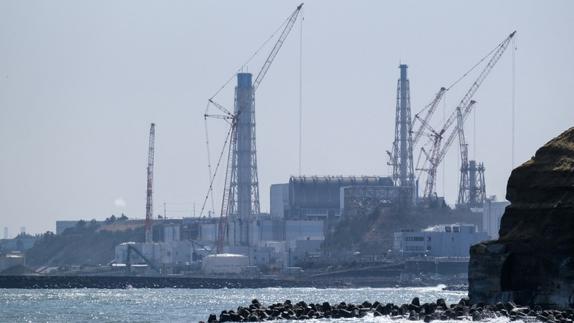 The Tokyo Electric Power Company Holdings (TEPCO) Fukushima Daiichi nuclear power plant is seen from the coast of Futaba town in Fukushima prefecture on March 10, 2021, on the eve of the 10th anniversary of the 9.0-magnitude earthquake which triggered a tsunami and nuclear disaster which killed over 18,000 people. (Kazuhiro NOGI / AFP)
The Tokyo Electric Power Company Holdings (TEPCO) Fukushima Daiichi nuclear power plant is seen from the coast of Futaba town in Fukushima prefecture on March 10, 2021, on the eve of the 10th anniversary of the 9.0-magnitude earthquake which triggered a tsunami and nuclear disaster which killed over 18,000 people. (Kazuhiro NOGI / AFP)
An increasing number of scientists are unconvinced by Japanese assertions that it will be safe to release radioactive water from the destroyed Fukushima nuclear power plant into the Pacific Ocean.
Shaun Burnie, a senior nuclear specialist with Greenpeace East Asia, told China Daily in an emailed statement that Japan, as well as the United States, did not fully disclose the risk from the contaminated water.
"What the Japanese government and it appears the US are not accurately representing are the risks from tritium, including the issue of organically bound tritium-OBT. This is where 3-9 percent tritium becomes bound into the cell structure of plants, animals and potentially humans-at which point there is a risk of cell damage," he said.
On Tuesday, Japan said it would start releasing treated radioactive water from the stricken Fukushima Daiichi nuclear plant in about two years. The decision has drawn fierce criticism at home and abroad.
Burnie said that by failing to explain the role of OBT, the Japanese government and the Tokyo Electric power Company, or TEPCO, are not providing accurate scientific data on the potential impact of any future release of contaminated water.
Greenpeace has consulted Ian Fairlie, an expert on radiation in the environment. Citing Fairlie's opinion, Burnie said: "The problem is that the ICRP/IAEA (International Commission on Radiological Protection/International Atomic Energy Agency) dose models are for single discharges, but when multiple discharges occur, the levels of OBT build up gradually."
Shaun Burnie, a senior nuclear specialist with Greenpeace East Asia, told China Daily in an emailed statement that Japan, as well as the United States, did not fully disclose the risk from the contaminated water
ALSO READ: Fukushima: Seoul aims to fight Japan's decision at world court
The US government extended its support for Japan's decision to dump wastewater from the Fukushima plant into the ocean.
The Fukushima crisis started in March 2011 when a 9.0 magnitude earthquake struck off the northeast coast of Japan and triggered a powerful tsunami. Three nuclear reactors at the Fukushima plant melted down because the tsunami knocked out the cooling system of the reactors. To keep the damaged reactor cores from melting, plant operator TEPCO pumped seawater into the reactor cores to cool them. Over time, the operator has stored 1.25 million tons of wastewater in tanks. Space to store the liquid will fill up by 2022.
The IAEA welcomed Japan's plan and said the proposed release of water into the ocean falls in line with international practice.
Aside from environmental groups, communities in Japan reliant on fishing worry that consumers will no longer buy products from the region.
Burnie noted that the radioactive waste that Japan plans to discharge contains many types of radioactivity, which behave differently in the environment and also have many different half-lives-a term that means the amount of time it takes for the radioactivity to decay by 50 percent.
READ MORE: Fukushima decision roils certain Chinese stocks
Lasting impact
One example of a long-lived radioactive isotope is carbon-14, which has a half-life of 5,370 years, he said."Carbon-14 ... once introduced into the environment it will be delivered to local, regional and global populations for many generations," he said.
Other scientists also have pointed to the existence of other isotopes in the radioactive water. In addition to tritium, more dangerous isotopes with longer radioactive lifetimes-such as ruthenium, cobalt, strontium and plutonium-sometimes slip through the filtration process. TEPCO only acknowledged this problem in 2018, according to Science magazine.
"These radioactive isotopes behave differently than tritium in the ocean and are more readily incorporated into marine biota or seafloor sediments," Ken Buesseler, a marine chemist at the Woods Hole Oceanographic Institution in Massachusetts, told the magazine.
An import restriction on Japanese food that likely contains radionuclide contamination will remain active despite the US government's backing of Japan's decision to dump the wastewater into the ocean.
In an update this month, the US Food and Drug Administration said it will retain an order that directs personnel from the agency to detain a list of Japanese food without physical examination due to nuclear contamination. The list includes milk, fish, sea urchins, meat and poultry, as well as vegetable products.


